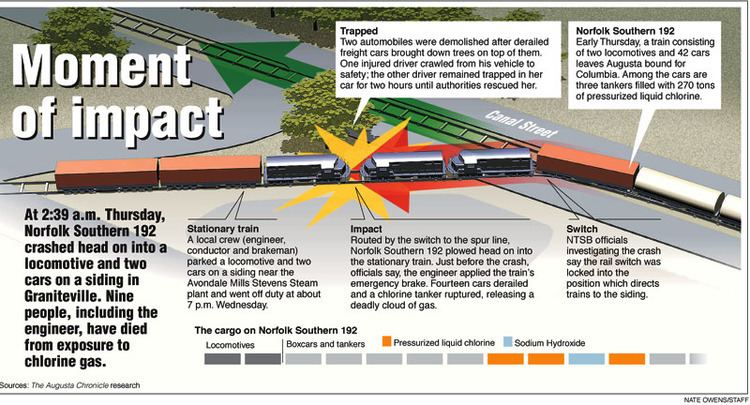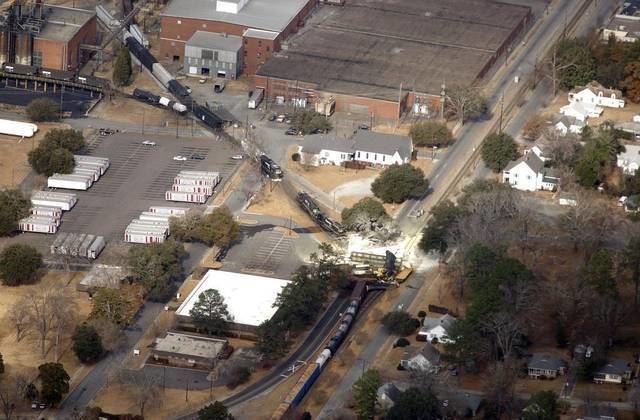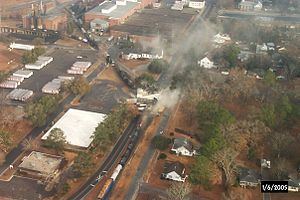Time Around 2:40 am Type of incident Collision Date 6 January 2005 Operator Norfolk Southern Railway Location Graniteville | Country United States Trains 2 Total number of deaths 9 Injuries 250 | |
 | ||
Cause Incorrectly aligned railroad switch Location Graniteville, South Carolina, United States Similar 2005 Glendale train crash, Ghotki rail crash, 1987 Maryland train colli, 2008 Chatsworth train colli, Great Train Wreck of 1918 | ||
The Graniteville train crash was an American rail disaster that occurred on January 6, 2005, in Graniteville, South Carolina. At roughly 2:40am EST, two Norfolk Southern trains collided near the Avondale Mills plant in Graniteville. NS local P22 (lead engine GP59 #4622) was parked on a siding near the Avondale Mills plant. NS freight train 192 (lead engine SD60 #6653), which was transporting chlorine gas, sodium hydroxide and cresol, was diverted by an improperly lined railroad switch onto the siding and collided with P22.
Contents

The collision derailed both lead engines, 16 of 192's 42 freight cars, and one of P22's freight cars. One of 192's tank cars (loaded with 90 tons of chlorine) ruptured, releasing about 60 tons of the gas. About 30% of the load was recovered by industrial responders. Nine people died (eight at the time of the accident, one later as a result of chlorine inhalation), and at least 250 people were treated for chlorine exposure. In total, 5,400 residents within one mile (1.6 km) of the crash site were forced to evacuate for nearly two weeks while HAZMAT teams and cleanup crews decontaminated the area.

Victims
Nine people lost their lives in the Graniteville train disaster on the day of the accident:


On April 21, 2005, one more death was attributed to the accident. Leonard Mathis, a brick mason in Graniteville, was driving home from a convenience store just after the accident occurred. As he was traveling home, he passed through a portion of the chlorine cloud that resulted from the collision. His health deteriorated from that point on.
Economic consequences
Norfolk Southern announced that it expected the disaster to cost between $US 30 and $40 million, including the corporation's self-insurance retention under its insurance policies and other uninsured costs, but not any fines or penalties that might be imposed.
On May 25, 2005, lawyers involved in the damages claims against Norfolk Southern announced that they had reached a preliminary agreement on settlements for area residents and business that were evacuated but did not seek medical attention. In this preliminary settlement, Norfolk Southern would offer each resident who was evacuated and did not seek medical attention within 72 hours of the accident a flat amount of $2,000 for the evacuation plus $200 per person per day of the evacuation. These amounts are separate from any property damage claims. Claims that involve injury or death are not included in this settlement, but are still being negotiated.
On May 22, 2006, Avondale Mills' CEO, Robert Williams Sr., announced that his firm would close all its plants, corporate and sales offices no later than July 25, throwing more than 4,000 workers across four states out of work. Mr. Felker cited the 2005 derailment as the primary reasons for the company's failure. The wreck knocked out the Gregg plant of Avondale mills, which was a key pillar to the survival of the company in a shrinking United States textile market. The plant accounted for 40% of the company's sales. Stephen Felker Jr., Avondale's manager of corporate development stated,"We were prepared to weather the storm of global competition. What we weren't prepared for was an event such as this derailment, which was completely beyond our control." Avondale Mills Inc. reached a $215 million settlement with its insurance company for damages caused by the train derailment and fatal chemical spill.
It is generally assumed that since the plant would have been fully insured and/or covered by Norfolk Southern's accident insurance, that the owners chose to take the settlement money and leave rather than rebuild the damaged plant. However, G. Stephen Felker Sr. stated "We do not believe that the settlement fully compensates us for the full value of the losses incurred as a result of the Norfolk Southern derailment" and said that the company intends to pursue a lawsuit or seek a settlement against Norfolk Southern.
Findings and recommendations
On November 29, 2005, the NTSB issued a report officially blaming the accident on the P22 train crew's failure to reline the switch for mainline operations. The report concluded that neither equipment failure nor crew fatigue or drug or alcohol use was a factor in the accident. It further concluded that the level and immediacy of emergency response to the accident was wholly appropriate for the situation.
As a result of this accident and a similar accident on the Burlington Northern and Santa Fe Railway on January 8, 2005, the United States Federal Railroad Administration (FRA) released to railroads a reminder of federal regulations on procedures for turnout operation and safety procedures. Among the federal rules regarding turnouts are:
The FRA further recommended that railroads should:
Litigation
Avondale Mills filed suit against Norfolk Southern claiming that the railroad was negligent in its operations through Graniteville and that this alleged negligence was the root cause of the accident. After the accident, Avondale Mills was closed, laying off thousands of employees and paid more than $140 million on cleanup and repair expenses. The trial opened on March 10, 2008, in federal court in Columbia, South Carolina.
On April 7, 2008, Norfolk Southern and interests representing Avondale Mills, and its surviving entities, reached a confidential out of court settlement.
On April 24, 2008, Norfolk Southern was sued by the U.S. EPA for violations of the Clean Water Act, as Horse Creek had been polluted. In a similar lawsuit in Pennsylvania, where a derailed Norfolk Southern runaway train crashed, the state of Pennsylvania sued the railroad for similar violations and won several million dollars for environmental remediation. However, fines may be minimal when compared to the damage to the surrounding environment.
On March 8, 2010, Norfolk Southern Railway Company agreed to pay $4 million penalty to resolve alleged violations of the Clean Water Act (CWA) and hazardous materials laws for a 2005 chlorine spill in Graniteville, S.C. Under the settlement filed in federal court in Columbia, S.C., Norfolk Southern will be required to pay a civil penalty of $3,967,500 for the alleged CWA violations, to be deposited in the federal Oil Spill Liability Trust Fund. The alleged CWA violations, included in an amended complaint filed in March 2009, are for the discharge of tons of chlorine, a hazardous substance, from a derailed train tank car and thousands of gallons of diesel fuel from ruptured locomotive engine fuel tanks. For the alleged Comprehensive Environmental Response, Compensation, and Liability Act (CERCLA) violation for failure to immediately notify the National Response Center of the chlorine release, Norfolk Southern will pay a penalty of $32,500, to be deposited in the Hazardous Substance Superfund. Under the terms of the agreement, Norfolk Southern will provide incident command system training to environmental and transportation personnel; stock nearby Langley Pond with at least 3,000 fish to replace fish killed by the chlorine spill; and post the telephone number for the National Response Center to facilitate spill reporting. Further, the settlement includes a supplemental environmental project (SEP) valued at $100,000 to plant vegetation along the banks of Horse Creek to decrease erosion and sedimentation, thereby improving water quality in Horse Creek.
Related information
On May 24, 2005, Norfolk Southern was awarded the TRANSCAER National Achievement Award for 2004. TRANSCAER is an acronym for Transportation Community Awareness and Emergency Response, which aims to promote emergency preparedness among first responders and communities for accidents that involve chemical releases. Part of the reasons for NS's selection for this award were the emergency preparedness training that the railroad held in 18 of the 22 states through which the railroad hauls hazardous materials.
Texas folk artist Doug Burr memorialized the Graniteville accident in his song "Graniteville" in his 2007 released album On Promenade. The song is fictionalized account of a husband attempting to rouse his wife from sleep to escape the dangers of the chemical spill.
